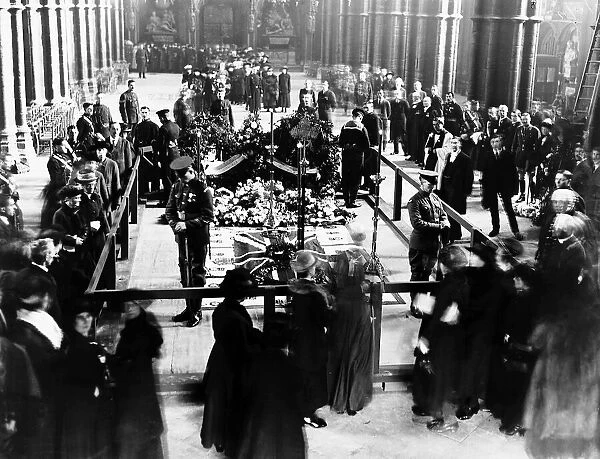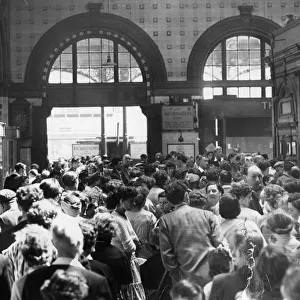Home > Mirror > 0100to0199 > 00167
Funeral of the unknown warrior at Westminster Abbey The idea of such a burial seems
![]()
Wall Art and Photo Gifts from Memory Lane
Funeral of the unknown warrior at Westminster Abbey The idea of such a burial seems
Funeral of the unknown warrior at Westminster Abbey
The idea of such a burial seems first to have come to a chaplain at the Front, the Reverend David Railton (1884-1955), when he noticed in 1916 in a back garden at Armentieres, a grave with a rough cross on which were pencilled the words " An Unknown British Soldier". In August 1920 he wrote to Dean Ryle, through whose energies this memorial was carried into effect. The body was chosen from unknown British servicemen exhumed from four battle areas, the Aisne, the Somme, Arras and Ypres. (The number of bodies exhumed varies in different accounts between four and six). The remains were brought to the chapel at St. Pol on the night of 7 November 1920. The General Officer in charge of troops in France and Flanders, Brigadier General L.J.Wyatt, with Colonel Gell, went into the chapel alone, where the bodies on stretchers were covered by Union Jacks. They had no idea from which area the bodies had come. General Wyatt selected one and the two officers placed it in a plain coffin and sealed it. The other bodies were reburied. In the morning Chaplains of the Church of England, the Roman Catholic Church and Non-Conformist churches held a service in the chapel before the body was escorted to Boulogne. The next day the coffin was placed inside another made of oak from Hampton Court sent over from England and wrapped in the flag that David Railton had used as an altar cloth during the War (known as the Ypres or Padres Flag, which now hangs in St Georges Chapel). Within the wrought iron bands of this coffin had been placed a 16th century crusaders sword from the Tower of London collection. The coffin plate bore the inscription " A British Warrior who fell in the Great War 1914-1918 for King and Country". The destroyer HMS Verdun, whose ships bell now hangs near the grave in the Abbey, transported the coffin to Dover and it was then taken by train to Victoria station in London where it rested overnight
Daily Mirror
mirrorpix
London
Greater London
England
WA*457762
Media ID 21483481
© Mirrorpix
1920 Armistice Day Core18 Funeral Memorial Remembrance Day Soldier Victims World War 1 World War One
MADE IN THE USA
Safe Shipping with 30 Day Money Back Guarantee
FREE PERSONALISATION*
We are proud to offer a range of customisation features including Personalised Captions, Color Filters and Picture Zoom Tools
FREE COLORIZATION SERVICE
You can choose advanced AI Colorization for this picture at no extra charge!
SECURE PAYMENTS
We happily accept a wide range of payment options so you can pay for the things you need in the way that is most convenient for you
* Options may vary by product and licensing agreement. Zoomed Pictures can be adjusted in the Cart.


